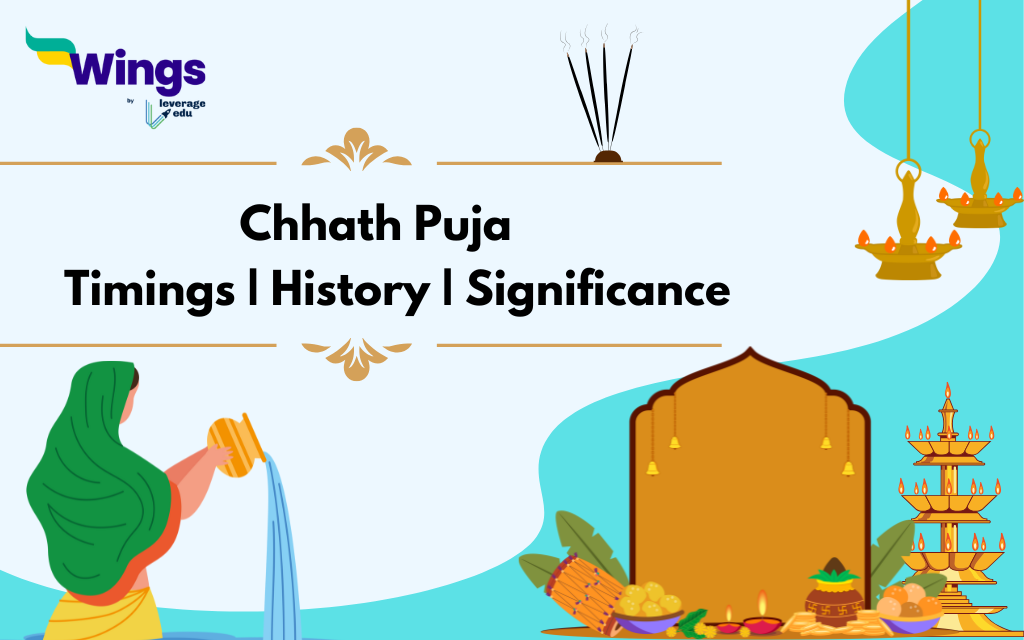Chhath Puja is a Northern Indian festival primarily celebrated in Bihar, Jharkhand, Uttar Pradesh, and Nepal, Chhathi Puja is widely observed. This festival honours Lord Surya and Goddess Usha, also known as Chhathi Mata. It is a festival of unity and harmony, where people come together to celebrate. In 2024, Chhath Puja will begin on Tuesday, November 5. In this blog, you will read all about Chhath Puja in English, its auspicious timings, history, and rituals.
Contents
Chhath Puja Calender 2024
Based on the Hindu Calendar, Chhath Puja is celebrated twice a year i.e. in the month of Chaitra and Kartik.
| Rituals | Date |
| Chhath Nahay Khay | 5 November 2024 |
| Lohanda and Kharna | 6 November 2024 |
| Sandhya Arghya | 7 November 2024 |
| Usha Arghya | 8 November 2024 |
Chhath Puja 2024 Timings
| Day | Sunrise | Sunset |
| Chhath Nahay Khay | 6:36 am | 5:33 pm |
| Lohanda and Kharna | 6:37 am | 5:32 pm |
| Sandhya Arghya | 6:38 am | 5:32 pm |
| Usha Arghya | 6:38 am | 5:31 pm |
History of Chhath Puja
There are different theories behind the history of Chhath Puja. While some devotees associate this Hindu festival with Ramayana, others think it originated from Mahabharata.
According to Hindu mythology, Chhath Puja started during the Vedic period, when sages performed the rituals for the first time. They used to fast for days and chant mantras.
Apart from this, some devotees believe that it was also performed by Karna, the son of Lord Surya and Mata Kunti. On the other hand, it is also believed that Draupadi, the wife of Pandavas, used to observe this fast for the well-being of her husbands and children.
Also Read: Why Do We Celebrate Chhath Puja?
What do the Chhath Rituals Mean?
1. Nahay Khay:
Nahay Khay marks the beginning of Chhath Puja. On the first day, worshippers eat kaddu (pumpkin) and arwa (rice) for dinner after taking a dip in a sacred river or pond.
2. Lohanda and Kharna:
The second day is dedicated to a rigorous fast observed by the devotees, after which they prepare a special prasad (offering) of fruits, jaggery, and thekua, a sweet snack. However, they cannot drink water throughout the day. They can only break their fast after sunset.
3. Sandhya Arghya:
The most important day is the third one. ‘Arghya’ is offered to the rising sun by devotees who congregate at the riverbanks prior to sunrise. Once this ritual is completed, they break their fast.
4. Usha Arghya:
The fourth and last day of Chhath Puja is Usha Arghya. The same ceremony of offering “Arghya” is carried out at dusk on the last day.
Why is Chhath Puja Celebrated?
Harvest Festival:
Chhath Puja is an important harvest festival as well. Farmers celebrate it in the post-harvest season, thanking the sun for a plentiful harvest and offering prayers for their land’s fertility.
Spiritual Significance:
Many people view Chhath Puja as a festival that purifies the soul. Worshippers observe strict fasts and present their prayers to the sun in the morning and evening. It is said that doing this will purify the body and mind and bring wealth.
Worshipping the Sun God:
The purpose of Chhath Puja is to honour Surya, the sun god. The sun is considered the source of life and energy, and devotees offer their prayers to seek blessings for the well-being of their families.
Interesting Reads
FAQs
Chhath Puja is widely celebrated in North India specifically in Bihar, Jharkhand, and Eatsern Uttar Pradesh. This festival is also popular in Nepal. Chhath Puja is dedicated to Lord Surya (sun) and Chhathi Mata (also named Goddess Usha, the sister of Lord Surya).
Chhath Puja is devoted to God sun and Chhathi Mata. The sun is the main source of life on Earth. It is necessary for all living creatures and for plants. Chhath Puja is a four-day-long Indian spiritual ritual. This Puja is done to thank Lord Surya.
The 4 days of Chhath Puja include Nahay Khay, Lohanda and Kharna, Sandhya Argha, and Usha Arghya.
For more information about such informative articles, make sure to check the trending events page of Leverage Edu.
 One app for all your study abroad needs
One app for all your study abroad needs














